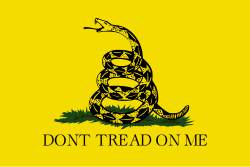History
Tea Party movement
(2010–2015)
(2015–2017)
The Tea Party Caucus grew out of the Tea Party movement, a conservative populist political movement that emerged in 2009 in the United States, generally opposing excessive taxation and government intervention in the private sector while supporting stronger immigration controls. [31] On February 19, 2009, [32] in a broadcast from the floor of the Chicago Mercantile Exchange, CNBC Business News Network editor Rick Santelli loudly criticized the government plan to refinance mortgages as "promoting bad behavior" by "subsidizing losers' mortgages", and raised the possibility of putting together a "Chicago Tea Party in July". [33] [34] A number of the traders and brokers around him cheered on his proposal, to the apparent amusement of the hosts in the studio. It was called "the rant heard round the world". [35] Santelli's remarks "set the fuse to the modern anti-Obama Tea Party movement", according to journalist Lee Fang. [36]
The following day after Santelli's comments from the Chicago Mercantile Exchange, 50 national conservative leaders, including Michael Johns, Amy Kremer and Jenny Beth Martin, participated in a conference call that gave birth to the national Tea Party movement. [37] [38] In response to Santelli, websites such as ChicagoTeaParty.com, registered in August 2008 by Chicago radio producer Zack Christenson, were live within twelve hours. [39] About 10 hours after Santelli's remarks, reTeaParty.com was bought to coordinate Tea Parties scheduled for the 4th of July and within two weeks was reported to be receiving 11,000 visitors a day. [39] However, on the contrary, many scholars are reluctant to label Santelli's remarks the "spark" of the Tea Party considering that a "Tea Party" protest had taken place 3 days before in Seattle, Washington [40] In fact, this had led many opponents of the Tea Party to define this movement as "astroturfed", but it seems as if Santelli's comments did not "fall on deaf ears" considering that, "the top 50 counties in foreclosure rates played host to over 910 Tea Party protests, about one-sixth of the total". [40]
An article in Politico stated that many Tea Party activists see the Caucus as an effort by the Republican Party to hijack the movement. Utah congressman Jason Chaffetz refused to join the Caucus, saying "Structure and formality are the exact opposite of what the Tea Party is, and if there is an attempt to put structure and formality around it, or to co-opt it by Washington, D.C., it's going to take away from the free-flowing nature of the true tea party movement." [41]
In an attempt to quell fears that Washington insiders were attempting to co-opt the Tea Party movement, Michele Bachmann stated "We're not the mouthpiece. We are not taking the Tea Party and controlling it from Washington, D.C. We are also not here to vouch for the Tea Party or to vouch for any Tea Party organizations or to vouch for any individual people or actions, or billboards or signs or anything of the Tea Party. We are the receptacle." [42] [43]
Additionally, Senators Ron Johnson of Wisconsin, Pat Toomey of Pennsylvania and Marco Rubio of Florida, all Tea Party supporters, refused to join the caucus. [44] [45] Toomey said he would be "open" to joining, and spoke at the first meeting, but did not ultimately join. [46] Johnson said that he declined to join because he wanted to "work towards a unified Republican Conference, so that's where I will put my energy." [47] Rubio criticized the caucus, saying "My fear has always been that if you start creating these little clubs or organizations in Washington run by politicians, the movement starts to lose its energy." [48]




